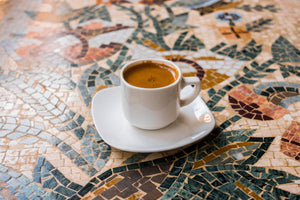Everyone has heard of espresso – and most of us have tried one, too. But what is espresso, and how is it different from coffee? Is it a type of bean, a blend, or a brewing method? And what’s so special about it?
If you’re not entirely sure, keep reading. Today, we’re breaking down everything you need to know about this iconic coffee shot.
What is Espresso?
Espresso is not just a shot of coffee, and it’s not a type of bean, either – it’s a brewing method. When making espresso, the temperature of the water is hotter than usual (almost at boiling temperature). When forced through very finely ground and tightly packed coffee beans at high pressure, it produces the so-called espresso.

Finely ground beans have more surface area, which means more flavor and caffeine gets extracted when brewing. And with hotter water, even more of the good stuff is pulled from the grounds, resulting in a brew that is rich, bold, and highly caffeinated.
In contrast to regular coffee, espressos are typically a little thicker and served in small shots. They’re also topped with the signature “crema” – a rich, brown foam produced from the soluble oils in the grounds.
Because of the tightly packed grounds and the high water temperature, there’s precision involved in the making of an espresso. If the water is too hot, you might end up with a burnt taste, and if you brew for too long, it might become too bitter.
What is an Espresso Blend?
But if espresso is a brewing method, then what are all these espresso beans and blends you see around coffee shops and grocery stores?
Well, you can make espresso with any and all kinds of coffee beans – as we said, it’s a brewing method, not a type of coffee. But some beans and roasts are particularly well-suited for espressos. So, if the beans are destined for this popular caffeine shot, roasters sometimes keep that in mind while preparing the beans.

Dark roasts do especially well in espressos. Many roasters also prefer high-quality robusta beans for espresso blends, just for that extra kick of caffeine. But high-quality really is the key word, here. Since espressos have a high level of extraction, the quality of the beans used tends to come through. While rich flavor profiles shine even brighter, lower-quality beans can fall a bit flat.
How Much Caffeine Is In Espresso?
Now, let’s get down to business. How much caffeine is in espresso, compared to regular coffee?
First, a caveat – the exact amount of caffeine in both espresso shots and regular cups of joe depends on which beans you use. To begin with, Arabica and Robusta beans contain different amounts of caffeine. But roast levels and how you measure out your beans can also affect how much actually ends up in your cup. If you’re curious to learn more, check out our breakdown of caffeine in coffee here.
Espressos have a reputation for being highly caffeinated, and where there’s smoke, there’s fire. The magic of this brewing method is that in just thirty quick seconds, you have a fresh shot of coffee that contains about 60-70% of the caffeine in the grounds.
And if you compare espresso and coffee, you’ll find that per fluid ounce, espresso has almost four times as much caffeine as regular coffee. The average for espresso is about 42mg per fl.oz, while drip coffee hovers at about 11.5mg per fl.oz.

However, serving sizes differ drastically between drip coffee and espresso. A single shot of espresso is usually about 1.5 fl.oz, while a regular cup of coffee is around 8 fl.oz. So in reality, a shot of espresso and a normal-sized cup of coffee contain about the same amount of caffeine. In fact, depending on the brewing method and time, a regular cup of coffee can even contain more caffeine than a single shot of espresso.
Then, of course, there are double shots of espresso, which is exactly what it sounds like – and it’s easy math. If you need that extra energy kick, you know what to order.
How to Drink Espresso
Despite being called a shot, espresso isn’t necessarily meant to be downed in one go. Like any other coffee drink, it’s best enjoyed in sips, letting you savor the aromas and flavors before it’s gone. In Italy, the homeland of espressos, it’s usually served without milk and sweeteners, but with a complimentary glass of water on the side.

Some people like to skim off the crema before they sip away, while others like to stir it into the brew itself. But, since much of the syrupy notes tend to sink to the bottom and the lighter flavors swim at the top, stirring your brew before drinking isn’t a half-bad idea.
Apart from drinking espressos as they are, their intense flavor also makes them popular ingredients in various coffee drinks, such as:
- Caffé Latte – a single or double shot of espresso, combined with steamed milk.
- Cappuccino – a single or double shot of espresso, combined with steamed and frothed milk (but less milk than in a latte).
- Red eye – a single shot of espresso, combined with filtered coffee.
- Americano – an espresso with a splash of hot water.
- Macchiato – an espresso topped with frothed milk.
There are plenty of other coffee drinks containing espressos, too, and thousands of variations in between. It even features in some alcoholic drinks, such as espresso martinis.
How to Make Espresso at Home
If you’re an espresso lover, don’t fret – you don’t have to constantly spend change at the coffee shop to get your daily shot. You can make them at home, too.
The easiest way to make espressos at home is to invest in an espresso machine. As we mentioned above, the perfect espresso is a bit of an art form, and getting the temperature and pressure right is a lot harder without a fine-tuned espresso maker.
But it’s not impossible. If you’re not quite ready to invest in an espresso machine yet, you can make do with a Moka pot.
It won’t give you the exact same effect as an espresso maker, and you might have to go without that delicious crema – but flavor-wise, it’s about as close as you’ll get. If you can get ahold of espresso beans, that’ll be even better.
Remember, two of the most important factors to making a great espresso are very fine coffee grounds and the right temperature to the water. So whichever method you use, pay attention to those and you should be good.
Espresso FAQ – All Your Questions Answered
Do you have more questions about espresso? Here’s a FAQ to solve any lingering question marks about espresso vs coffee.
Is Espresso Stronger Than Coffee?
Espresso contains more caffeine than drip coffee per fl. oz. However, because the espresso shot is much smaller than a regular cup of coffee, the amount of caffeine per serving comes out to about the same. Sometimes, a cup of coffee can even contain more caffeine than espresso.
Does Espresso Taste Different Than Coffee?
Yes, regular coffee and espresso taste a bit different. Espresso is a very concentrated shot of coffee, so it tends to have a bold, aromatic flavor and is typically thicker in consistency.
The short brewing time of espresso means that fewer acids are extracted, while the high pressure and lack of a filter let through more of the coffee’s oils. This makes for a more intense, and often less acidic, flavor profile.

How Many Espressos Can I Drink In a Day?
Research has found that drinking about 400mg of caffeine per day is perfectly fine. A single shot of espresso contains about 65mg of caffeine (varying slightly between beans and roasts), so if you don’t consume any other caffeine, drinking up to 5 or 6 shots per day should be okay.
However, caffeine can impact your sleep, and it’s worth keeping in mind that if you drink caffeine late in the day, it may keep you awake at night or leave you feeling jittery.
Is Espresso Healthy?
Like all coffee, espresso comes with many health benefits. Coffee is rich in antioxidants, and long-term this could help prevent certain degenerative diseases and health conditions.
But people’s tolerance of coffee and caffeine varies, so each person has to listen to their own body to know how much coffee is healthy for them to drink. Generally, espressos are less acidic, which could make it a good option for people with sensitive stomachs.
Is Espresso Less Acidic than Regular Coffee?
Yes, because of espresso’s short brewing time, it tends to be less acidic than drip coffee. Exact acidity levels, however, also depend on many other factors including type of bean, roast level, and how you measure out your beans.
Where Does Espresso Come From?
Espresso was invented in Venice, Italy in the early 1900s, when a businessman called Luigi Bezzera was experimenting with ways to make coffee faster. “Espresso” itself translates to simply, “fast”.
How Long Does it Take to Make an Espresso?
Espresso is famous for being one of the fastest coffee brewing methods, and the actual brewing time can be as quick as less than 30 seconds. If you also count the preparation of beans, water, etc. it takes a little longer.
Can You Make Espresso Cold Brew?
Espresso and cold brew are two very different brewing methods, but of late, so-called “espresso cold brew” has become popular, bringing the unique flavor profile of espresso to the cold brew’s less acidic and smoother flavor.
To make espresso cold brew, you simply choose espresso beans and grind them finely, before letting them steep for 12–24 hours according to the cold brew method. Just make sure to filter properly, since the grounds are much finer than in regular cold brew and may not be as easy to get out of the cold brew before drinking!
And there you go – every nitty, gritty detail you need to know about espressos. Now, the next time you get the question “What is espresso?”, you’ll be able to answer with confidence. And if you’re ready to try making one at home, go check out our delicious dark roast beans. We’ll deliver a free sample right to your front door, so you can get into your caffeinated peak state pronto!
Psst… Do you know how to make the perfect cold brew at home? Check out our best tips here!

